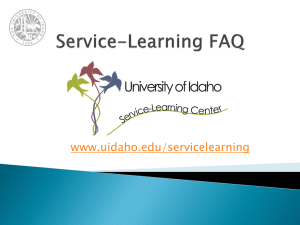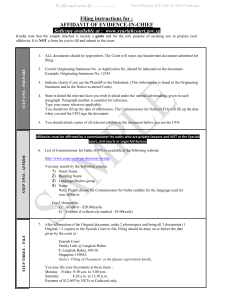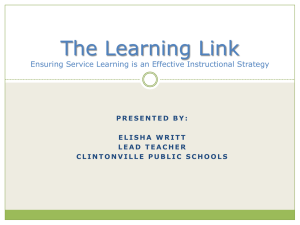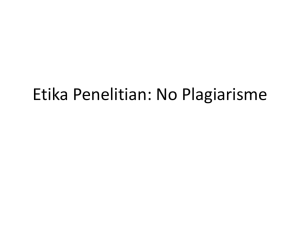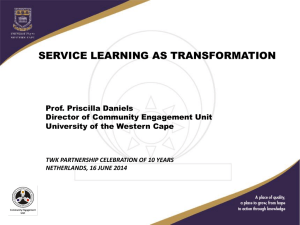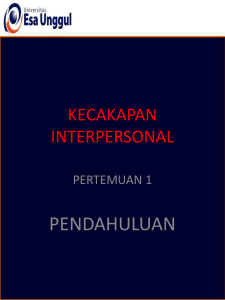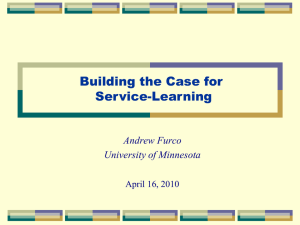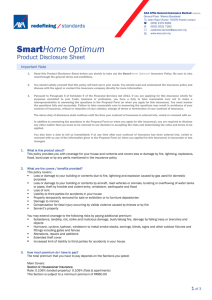Introduction to Service-Learning (for Student)
advertisement
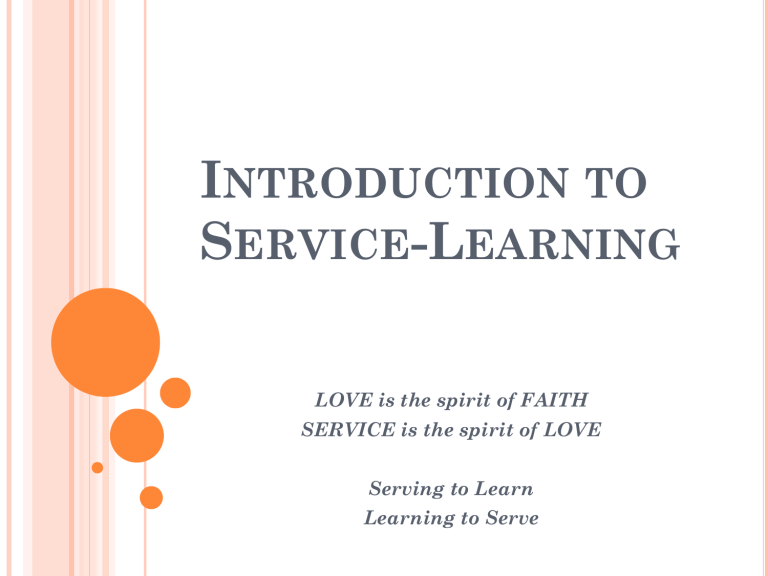
INTRODUCTION TO SERVICE-LEARNING LOVE is the spirit of FAITH SERVICE is the spirit of LOVE Serving to Learn Learning to Serve WHY SHOULD BE SERVICE-LEARNING? Vision: To be a caring and global university that is committed to Christian values LIGHT value: Love – is the spirit of caring Integrity – is character in action Growth – is the fruit of holistic learning Humility – is the beginning of wisdom Truth – is the basis of true life Profile of Alumni: Academic excellence, Emotional excellence, and Spiritual excellence WHY SHOULD BE SERVICE-LEARNING? Emotional Excellence Academic Excellence Spiritual Excellence Holistic Education SL is a holistic education which integrates all student aspects: academic, emotional, spiritual SERVICE AND LEARNING TYPOLOGY SYGMON, 1994 Service-LEARNING Learning goals primary Service outcomes secondary SERVICE-learning Service outcomes primary Learning goals secondary Service Learning Service and learning goals completely separate SERVICE-LEARNING Service and learning goals of equal weight. Each enhances other for all participants EXPERIENTIAL LEARNING CONTINUUM Who is BENEFITTING? Recipient Provider What is the main FOCUS? Service Learning SERVICE-LEARNING COMM. SERVICE VOLUNTEERISM FIELD EDUCATION INTERNSHIP Adapted from Furco, 1996 VOLUNTEERISM Volunteerism refers to people who of their own free will and without pay, perform some service or good work (such as with charitable institutions or community agencies). Many of you may have volunteered while growing up through scouting, 4-H, church youth groups or other organizations. COMMUNITY SERVICE Community service is a form of volunteerism. The important point here is that the community service is done within in a defined community. Some examples could include: your classroom, your school, the town where your students live their city, etc. There does not have to be an intentional attach to learning; the emphasis is placed strictly on the service that is performed. INTERNSHIPS Student the primary beneficiary Focus on student learning Goal is to acquire skills and knowledge FIELD EDUCATION Service activities related to but not fully integrated into academics Focus on maximizing student learning WHAT IS SERVICE-LEARNING? A “teaching methodology that combines community service with explicit academic learning objectives, preparation and reflection Students provide community service but learn about the context in which it is provided, the connection between the service and their academic coursework, and their roles as citizens” (Seifer, CCPH, 2000). SERVICE-LEARNING Equal benefit to provider and recipient of service Equal focus on service and learning Every individual, organization, and entity involved functions as both teacher and learner Must have academic context that ensures Service enhances learning Learning enhances service GRADUATION REQUIREMENT Service-Learning is a must for each student Since 2011, each student should take minimum one Service-Learning course TYPES OF SERVICE-LEARNING (SL) Mono-discipline SL Organized at department level Multi-discipline or inter-discipline SL Organized at faculty or university level REQUIREMENT FOR SERVICE-LEARNING Link to Curriculum Meaningful SL through service practicum Reflection Diversity Partnership Progress Monitoring/Mentoring Duration and Intensity PACKAGING DESIGN COURSE • National Award: 1st winner Pack 2i Academy Design Award for Herbal Category, 2009 • Asia Award: Award for Packaging Excellence Asia Star 2009 (Students Category) ELEMENTS OF SERVICE-LEARNING Preparation Celebration Elements of SL Reflection Action PREPARATION Knowledge for the project (Lecturing in class, mentoring) Preparation includes everything that is done to help the participants develop the necessary skills ACTION The meaningful service performed by participants can take many forms and may include teaching others, creating a product or performance, providing a service or advocating for change. The action can occur in one day, over a particular week, as well as over the course of several months. REFLECTION Processing or reconstructing the service experience helps to make the connection to learning. Could take many different forms. For example: writing, doing, telling, and reading etc. Why reflect? • Reflection is crucial for integrating the service experience with classroom topics. • We do not learn from experience unless we take time to reflect on it. • Without reflection, our service is merely volunteerism--not service-learning. • It helps us to take notice of what we are learning from our service experiences--similar to the way that one highlights the important parts of a book with a color marker. • It is these “highlights” that help students bridge classroom theory with the real world. STUDENTS’ REFLECTIONS I am used to live with AC, so when I went to the gempol kurung village, it was so hard for me because the weather is so hot. I thought that this class is too hard physically and also I have to spend a lot of money. And when I went to the field for monitoring by our own group , we got lost and my car got stuck in a dry ditch …. Even though we finally came to the place, we felt it was bad experience. The thing that touched me was when the owner of the house smiled and said thank you for helping them in getting a better house. I was encouraged when I saw the Surabaya International High School students show great enthusiasm during the BOSS program. dipersiapkan oleh Prof. Lilianny S Arifin - UK Petra STUDENTS’ REFLECTIONS I never knew that there are poor communities in reality. I ever saw it only on television. So when I went to the gempol kurung village and kedung turi kampung, I felt so grateful that I can live prosperously . The thing that I could not forget was after joining the BOSS program, my body hurt all over and I could not walk properly on the next day. This hurt continued for 3 days. I felt touched by the poorness of this community, so I want to find donation to help these people get a comfortable life. dipersiapkan oleh Prof. Lilianny S Arifin - UK Petra PANDUAN REFLEKSI Awal Perkuliahan Apakah yang anda harapkan dengan mengikuti mata kuliah ini? PANDUAN REFLEKSI Selama survey Apakah kegiatan yang anda lakukan ? Deskripsikan dengan jelas ! Apakah kendala yang anda hadapi ? Bagaimana solusinya ? Pelajaran berharga apa yang anda dapatkan ? PANDUAN REFLEKSI Setelah implementasi proyek Bagaimana pendapat anda mengenai komunitas yang anda layani? (perspektif ekonomi, sosial, dan budaya) Bagaimana pencapaian tujuan anda? Faktorfaktor apakah yang membuat berhasil/tidaknya proyek anda? Pelajaran berharga apakah yang anda dapatkan dari komunitas yang dilayani? PANDUAN REFLEKSI Setelah implementasi proyek Nilai-nilai karakter dan softskill paling menonjol apakah yang anda dapatkan ? Bagaimana kegiatan ini dapat menolong anda untuk lebih mengenal diri anda sendiri? Bagaimana metode SL ini dapat menolong anda memahami mata kuliah? Apakah yang anda harapkan seperti di awal perkuliahan tercapai? PANDUAN REFLEKSI Setelah implementasi proyek Bagaimana pendapat anda mengenai komunitas yang anda layani? (perspektif ekonomi, sosial, dan budaya) Bagaimana pencapaian tujuan anda? Faktorfaktor apakah yang membuat berhasil/tidaknya proyek anda? Pelajaran berharga apakah yang anda dapatkan dari komunitas yang dilayani? PANDUAN REFLEKSI Nilai-nilai karakter dan softskill paling menonjol apakah yang anda dapatkan ? Bagaimana kegiatan ini dapat menolong anda untuk lebih mengenal diri anda sendiri? Bagaimana metode SL ini dapat menolong anda memahami mata kuliah? CELEBRATION/DEMONSTRATION It’s important to acknowledge that participant and communities have completed their project and done a GREAT job. Everyone that participated in doing the service should be included in the celebration/demonstration. This should include public officials, site personnel and the media. Students now have the opportunity to show what they have accomplished. OTHER IMPORTANT ELEMENTS PARTICIPANT VOICE Participants should play an active role in the selection, design, implementation, as well as evaluation of the service learning project. GENUINE NEED It is important that the service learning project meet a genuine/true community need. CONNECTION TO LEARNING Effective service learning establishes clear learning outcomes that require application of concepts, content and skills, as well as involve participants in the construction of their own knowledge. PARTNERSHIPS Promoting communication & interaction with the community encourages partnerships and collaboration. Partnerships can include: businesses, community organizations, historical societies, colleges/universities, public or private school, social service agencies and National Service Programs. PENGHARGAAN UTK Selain mendapatkan nilai mata kuliah, mahasiswa yang mengikuti mata kuliah berbasis Service Learning akan mendapatkan tambahan SKKK Pengabdian Masyarakat Mata Kuliah COP Mata Kuliah lain MAHASISWA : 3 SKKK : 1,5 SKKK Mahasiswa memperoleh sertifikat setelah lulus mengikuti SL. Sertifikat tanda peserta (tanpa nilai) dikeluarkan oleh program studi/program DOKUMENTASI KEGIATAN SL KEGIATAN MEMBANGUN RUMAH SEHAT KERJASAMA DENGAN HABITAT DOKUMENTASI KEGIATAN SL KEGIATAN DESAIN KEMASAN UMKM DI KEC RUNGKUT DOKUMENTASI KEGIATAN SL KEGIATAN MACAKI KAMPUNG DI SIWALANKERTO
